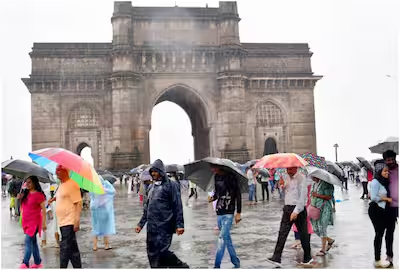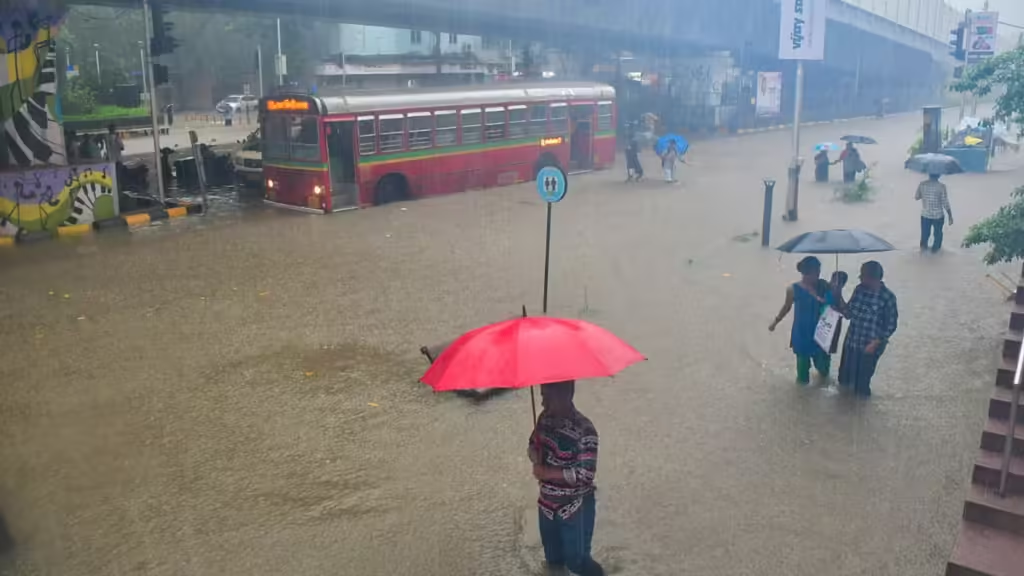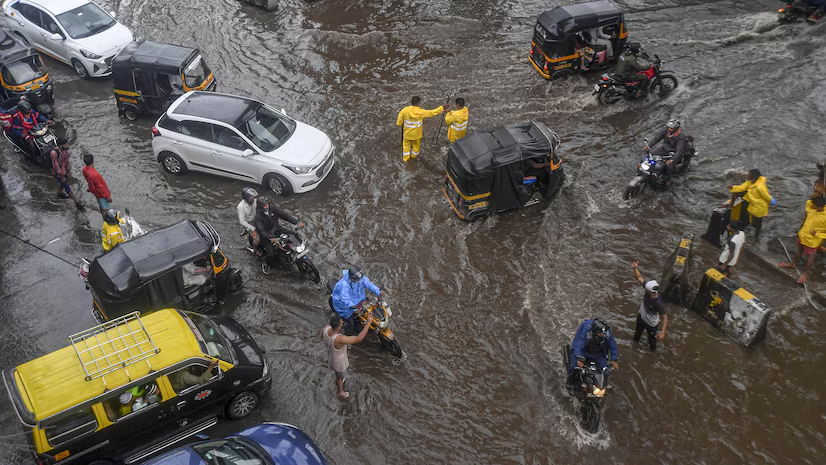| In Short |
| The IMD has issued a red alert in Mumbai due to heavy rainfall, with schools and colleges closed on September 26. |
| The BMC is actively monitoring the situation and taking steps to manage waterlogging and flooding. |
| Public transportation, including local trains and buses, has been significantly affected by the rains. |
| Residents are advised to stay indoors, avoid unnecessary travel, and follow safety guidelines. |
| Climate change is contributing to the increasing intensity of such weather events, highlighting the need for better preparedness. |
Mumbai, the financial capital of India, is bracing itself as heavy rains have led to the issuance of a red alert, causing authorities to announce the closure of schools and colleges on September 26. The India Meteorological Department (IMD) has warned of incessant downpours and possible flooding, urging citizens to exercise caution and stay indoors unless absolutely necessary.
Why Was a Red Alert Issued in Mumbai?
The IMD issued a red alert for Mumbai and the surrounding areas after recording continuous and heavy rainfall, which is expected to intensify in the coming days. A red alert indicates extremely heavy rainfall, meaning that the city could experience more than 20 cm (7.8 inches) of rainfall in a 24-hour period. This kind of weather poses significant risks, including flooding, traffic disruptions, and potential damage to infrastructure.
The IMD’s decision to issue a red alert was based on data showing that several parts of Mumbai have already experienced substantial rainfall, and forecasts predict that the intensity will increase further. The heavy rains could lead to waterlogging, disrupted transportation, and potential landslides in some areas, prompting the authorities to take precautionary measures.
Schools and Colleges Closed: An Important Precautionary Step
As a result of the red alert, the Brihanmumbai Municipal Corporation (BMC) announced that all schools and colleges in Mumbai would remain closed on September 26. This decision is part of a broader effort to ensure the safety of students and staff, preventing them from venturing out during hazardous weather conditions.

The closure of educational institutions is also intended to reduce traffic congestion and avoid overcrowding on public transport systems, which can become dangerous during heavy rains. Parents have been urged to keep their children indoors and avoid unnecessary travel until the weather situation improves.
Impact on Daily Life and Transportation in Mumbai
The heavy rainfall and the red alert have significantly impacted daily life in Mumbai, a city known for its resilience and bustling activity. Here are some of the effects that residents are currently experiencing:
1. Waterlogging and Flooding
- Several low-lying areas in Mumbai have reported waterlogging, making it difficult for vehicles and pedestrians to navigate the streets. This has caused traffic snarls, with many commuters facing long delays on their way to work or while returning home.
2. Public Transportation Disruptions
- Mumbai’s local train network, often referred to as the city’s lifeline, has been affected by the heavy rains. Trains are running at a slower pace, and some routes have been temporarily suspended due to waterlogged tracks. This has left thousands of commuters stranded and looking for alternative modes of transport.
- Bus services have also been affected, with delays and diversions reported in several parts of the city.
3. Flight Cancellations and Delays
- The Mumbai airport has seen flight delays and cancellations due to the adverse weather conditions. Passengers are being advised to check with airlines for updates on their flights before heading to the airport.
BMC’s Response and Safety Measures
The Brihanmumbai Municipal Corporation (BMC) has been on high alert, deploying emergency teams across the city to deal with the impact of the heavy rains. The BMC has taken the following steps to ensure public safety:
- Monitoring Waterlogged Areas: BMC officials are closely monitoring areas prone to flooding and have stationed pumps to drain excess water where necessary.
- Tree-Cutting and Road Clearance: Teams are on standby to clear fallen trees and debris from the roads to ensure smoother traffic flow.
- Emergency Helplines: The BMC has activated emergency helpline numbers for residents to report issues related to flooding, waterlogging, or any other emergencies caused by the heavy rains.

Authorities have also urged residents to stay indoors, avoid venturing into waterlogged areas, and refrain from using private vehicles unless absolutely necessary. The BMC has assured citizens that all necessary measures are being taken to manage the situation and minimize disruption to daily life.
How to Stay Safe During the Red Alert in Mumbai
If you’re in Mumbai during this red alert, it’s essential to take precautions to stay safe:
- Stay Indoors: Avoid going outside unless it is absolutely necessary, especially in areas prone to flooding or landslides.
- Avoid Using Private Vehicles: Use public transportation if you must travel, as the roads are likely to be waterlogged and traffic could be disrupted.
- Keep Emergency Contacts Handy: Make sure you have emergency contact numbers saved in case you need assistance.
- Follow Weather Updates: Stay updated with the latest weather forecasts and warnings from the IMD and BMC.
How Often Does Mumbai Experience Red Alerts?
Mumbai is no stranger to heavy rainfall, especially during the monsoon season, which typically lasts from June to September. However, red alerts are not issued frequently and are reserved for situations where the rainfall is expected to be exceptionally heavy, posing serious risks to life and property.
In recent years, Mumbai has experienced several incidents of severe flooding, which have disrupted normal life and caused damage to infrastructure. These events have highlighted the city’s vulnerability to extreme weather conditions and the need for better infrastructure and planning to manage such situations.
Climate Change and the Increasing Intensity of Rainfall
The heavy rains in Mumbai have reignited concerns about the impact of climate change on weather patterns in the region. Experts have warned that climate change is likely to increase the frequency and intensity of extreme weather events, including heavy rainfall, cyclones, and floods.
Mumbai, as a coastal city, is particularly susceptible to these changes, and the recent red alert serves as a reminder of the importance of preparing for such events. It underscores the need for investment in better drainage systems, flood management infrastructure, and disaster preparedness measures to protect residents and minimize damage.
A City on Alert
As Mumbai deals with the impact of heavy rains and the red alert, the safety of residents remains the top priority. The closure of schools and colleges, disruptions to transportation, and the measures taken by the BMC all reflect the seriousness of the situation.
Residents are urged to stay vigilant, adhere to safety guidelines, and keep themselves informed about the latest weather updates. While the rains may bring challenges, Mumbai’s spirit of resilience and preparedness will undoubtedly help the city navigate through this period.
Mumbai’s red alert serves as a reminder of the challenges posed by extreme weather events and the importance of staying informed and prepared to ensure safety during such times.
For Latest News Updates, Click Here.
